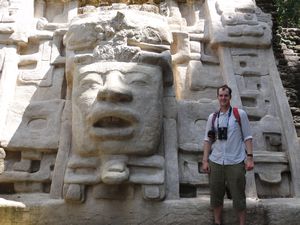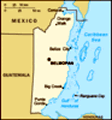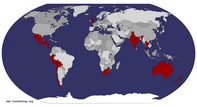Advertisement
Published: March 17th 2011

 Mask Temple
Mask Temple
The famous Lamanai masksAfter my brief stint in Mexico I retraced my steps south into Belize; having skipped straight across the country on the way to Caye Caulker my plan was to travel overland north-to-south taking in as many sights as possible along the way.
Lamanai
My first call was the town of Orange Walk in northern Belize, the town itself is not much to write home about (literally) but is situated close to the New River from where one can take a boat trip to see Lamanai, Belize's most famous Mayan ruin.
I joined the other day trippers just outside town & we all piled into a 20 seater launch with our guide. The river is surrounded by forests and an impressive collection of flora and fauna abides close to the waterway, within minutes of departure we were alongside a group of spider monkeys lolling between the trees occasionally giving us very appraising stares.
As we progressed upstream the river meandered and was forever splitting and recombining with tributaries, the guide must have had a great sense of direction because I was lost in minutes. The trees lining both riverbanks were a kind of special freshwater mangrove, our guide

 Mask Temple
Mask Temple
The pair of masks really dominate the temple.was a wealth of information and pointed out a couple other interesting species; one was called the Bullet Tree and is reputedly 100 times harder than mahogany, if you try and put a nail through it, the nail will just bend in two, the Mayans used this timber for lintels in Tikal, over 2000 years on they're still in place. Another was called the poison wood tree which, if cut, exudes an acidic sap that causes 3rd degree burns wherever it makes contact with skin, nice.
Along the way the boat stopped frequently to view sunbathing crocodiles and turtles as well as to admire the huge array of bird life including herons, raptors and kingfishers which all lined the trees and shallows. In slower moving parts of the stream water lilies sprouted from the river & were home to baby crocs as well as small birds with comically large feet, known locally as the Jesus Christ bird for it's ability to walk on water. The guide told us that they always look closely for when the migratory birds arrive because if they don't it preempts a particularly bad hurricane season. It was on this rather somber note that a Norwegian

 Steep Climb
Steep Climb
The steps up some temples were dangerously steep, this flight even warranted a rope.guy in the group piped up, "I know hurricanes, there're like women, wild and wet when they arrive & they take your house and car when they leave".
The city of Lamanai - meaning submerged crocodile in Mayan - is right by the river and has been there for a very long time, founded around 1500BC, it was one of only three Mayan cities to survive the civilisation's fall. The site was inhabited by indigenous Mayans until the 1990's when eventually the site was turned over to tourism. The ruins are similar to Tikal in that there were a number of vast restored temples on the site, many with multi-tiered staircases leading to the top. The temples did not have the single grand staircase typified by the temples of Tikal because the Mayan rulers of the time used to build atop existing pyramids, covering the previous form with a new larger structure. It was because of these ancient extensions that the two enormous Mayan faces on the face of the first temple we visited were so wonderfully preserved; hidden behind a thick masonry wall for thousands of years they now beautifully adorn the facade of Mask Temple.
Apparently

 Spider Monkey
Spider Monkey
Monkey at full stretch on the new river toward Lamanai.only 3-5%!o(MISSING)f the Mayan population - the elites - lived in these extensive temple complexes, the remainder or peasants lived on the periphery but still supplied all the food and labour. Apparently they were all quite happy with their lot because the lower orders belived they would be reincarnated as elites in the next life... all 95%!o(MISSING)f them, the can't have done the maths. Amusingly the only other way to become an elite was to be born a midget, many carvings show a Mayan king with a midget by his side.
During the tour through the site, a ruckus suddenly started in the canopy
above us; two opposing families of howler monkeys were facing off over territory with a cacophony of deafening roars and grunts, quite a spectacle, they've really got quite a set of lungs.
Heading South
On the way south I stopped off at Belize Zoo near the centre of the country, the zoo was founded as a home for semi tame animals that had been used in an American documentory but now houses many of Belize's endangered specues. At this point I was traveling with a Norwegian couple (of hurricane fame) and we
decided having collectively spent many days in national parks seeing diddly squat, this would be a good opportunity to see all the famous animals of Central America in one go. The zoo didn't disappoint; right by the entrance was a python wrapped round the banister, my kind of zoo, within there were ocelots, pumas, tapirs and many other animals I'd never heard of. My highlight was getting to within 6" of a Jaguar, he was a big chap, actually quite glad in retrospect I didn't meet one in the wild.
The next morning the Norwegians & I went cave tubing on the Sibun River nearby, it was so lame it was comic. Clearly aimed squarely at cruise ship day-trippers, our guide was so used to half blind septuagenarians he pointed out ever protuberance in the well groomed pathways as a potential trip hazard, we had much fun at his expense pointing out every wet leaf and pebble that could bring about our doom. The trip was quite fun, after our perilous walk through the deadly jungle we jumped in the river on inner tubes and floated downstream with the river disappearing underground every now and then.
My next stop

 Belize Zoo
Belize Zoo
Jaguar - They had a raised walkway joining the Jaguar pens, we arrived just as this chap was crossing.along down the coast was Hopkins a small town on the Caribbean coast, in two days I managed to get stung by a jelly fish and bitten by a spider, the later making my hand swell up to about double its normal size, strangely I left not wholly enamored with Hopkins. I did see a group of kids trying to make sail in a large fridge, they made little progress but seemed delighted bobbing up and down 20' from shore. (Hopkins dock is shown on the panorama)
Belize has some beautiful places but with prices many times that of neighbouring countries my time there was limited, it was in fact quite a relief crossing back over the border to Guatemalan prices.
Livingston
Over the border once more for my final stop in Guatemala, Livingston. Lying at the mouth of Rio Dulce the town is accessible only by boat, I came in from Belize across the Gulf of Honduras. The town retains much of the Caribbean vibe I encountered further up the coast as practically all of Guatemala's black population reside in the vicinity (the majority were educated in Belize so there was also a smattering of

 Belize Zoo
Belize Zoo
The Scarlet Macaw, I hope to see these in the wild in Honduras.English about). Up the Rio Dulce is a town by the same name, it's for the boat trip connecting these two towns that the majority of travelers visit, therefore my first morning I went down to the docks for another days boat trip.
Motoring along the coast toward the river mouth every jetty and unoccupied vessel was covered in hundreds of large pelicans and other sea birds all making their presence known and jostling for position and diving into the water in search of their morning breakfast. Entering its mouth, the river was flanked by a steep walled gorge called Cueva de la Vaca, the walls of which are covered with thick jungle and must have been over 100m high; in places the walls formed vertical escarpments of white rock, all very impressive. Further inland the river widened into almost a lake which then extended up to Rio Dulce. The town is little more than a transit stop but is dominated by a huge concrete bridge spanning the river, the largest in central America I was reliably informed, (it was a bit ugly but I kept that opinion to myself)
The following morning I ran 5km along the
beachfront to see Livingston's other natural attraction, Los Siete Altares or the seven alters, these are a series of freshwater pools which work their way through the jungle over a series of unusual limestone waterfalls, there was not much water when I visited but enough for a welcome freshwater swim in one of the lagoons.
The entire stretch of beach I ran along was strewn with plastic that had been washed up on the sand, what appeared as areas of white pebbles were in fact rounded balls of polystyrene, added to this were discarded flip-flops, pens, and thousands of plastic bottles. I have seen this all over Central America from the shores of Lake Atitlan right down the Caribbean coast, what must once have been beautiful waterfronts now look more like rubbish dumps. What this concentration of human detritus will do to the wildlife and tourist trade only time will tell, what can be done, ban all plastic in the third world, I don't know, it's very sad. Sorry rant over.
I'm now in Utila, one of the Bay Islands off the coast of Honduras; I'm here doing my Divemaster qualification and will blog all about it in
six weeks time....
Advertisement
Tot: 0.166s; Tpl: 0.012s; cc: 18; qc: 89; dbt: 0.0992s; 1; m:domysql w:travelblog (10.17.0.13); sld: 1;
; mem: 1.3mb
















Cynthia
non-member comment
Great pics & Commentary
Hello, just wanted to thank you for the great pics and commentary on Belize. I was there in December, 2010. I went as far south as Punta Gorda, but did not venture into Guatemala or Honduras - that is for next time. I recall seeing women washing laundry along river banks, and yes, the ugly drift piles of plastic debris. We spend some time in Hopkins and our story from there is seeing how they recycle major applicances. We bought johnny cakes, fresh baked, from a Miss Gail's. Her electric range was gutted, out in the yard in the range, big stack of burning wood on top where the coils once were, and the cakes baked inside the oven! Not crazy about kids playing raft in a fridge, but they are simply carrying on a village tradition it seems of re-using stuff in novel ways. I hope they made it to shore ok but I imagine is now just one more big hunk of debris on the sea bottom. Again, thanks for posting. It brought back memories!